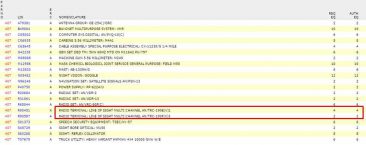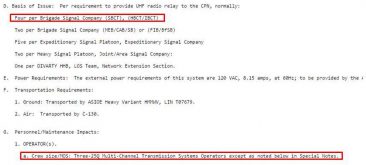I am a huge advocate of using HCLOS within out networks. It increases bandwidth, adds redundancy, and reduces delay between nodes. As I’ve noted before, deploying HCLOS within a decisive action (DA) environment can present some challenges however it is still more than possible. It is important to remember that prior to WIN-T, Mobile Subscriber Equipment (MSE) operated almost entirely with HCLOS.
As I’ve said before, when using HCLOS in a DA environment, it is often easiest and most practical to deploy these links with non-maneuver units (BSB, aviation, etc.). In several recent rotations though we have seen units experience an additional challenge in employing their HCLOS assets; HCLOS v1s being permanently placed with maneuver battalions.
When I talk to units, I am normally told that this assignment of HCLOS v1s to the maneuver battalions dates back to previous deployments to Iraq and Afghanistan. During those deployments, the units were static and operated off of FOBs making them good choices for HCLOS links. To make life easier for everyone, these systems were permanently attached (remember not even the Brigade Commander can change the MTOE, the Army has to do that which means that those systems are attached, not assigned) to their respective units. Unfortunately when the mission was changed from operating off of FOBs to operating across a dynamic battlefield, these old ties were never severed.
In units where this was the case, the unit would want to employ a HCLOS at a particular location only to run into problems actually moving the system to that location because the unit wasn’t willing to release the system and personnel. In another case, the unit was actually willing to move the system, but it was discovered that they had failed to bring a complete HCLOS access case and so the HCLOS was unable to connect to the CPN.
HCLOS v1 Fielding

Each BCT is authorized four HCLOS v1 shelters on their MTOE. These systems (along with the two HCLOS v3s) are located within the High Capacity Line of Sight paragraph of the signal company MTOE. The HCLOS v1s are placed within the signal company to allow for their easy reallocation across the brigade as the mission and network requirements change. According to the Basis of Issue Plan (BOIP) for the HCLOS v1 it states “At the Brigade level, the TRC-190C(V)1 will be documented in the Brigade Signal Company Network Extension Platoons. The Basis of Issue at the Brigade level reflects a “pool of resources” and by METT-TC, the BDE S6 will decide which BN CP Node receives the TRC-190C(V)1”.
The Army realized when it began to field units with their WIN-T equipment that the HCLOS v1 may be needed by anyone of a number of locations depending on how the mission and the network changed. In order to facilitate this, they placed the HCLOS v1s within the signal company which is already used to moving equipment (JNNs, retrans, etc) across the battlefield as mission dictates.

Another problem I frequently hear when it comes to employing the HCLOS is that they don’t have the operators to man the system. Again when you examine the BOIP for the HCLOS v1, it notes that the operators for the shelter is a crew of three 25Q Soldiers but it caveats that with a note that says “Each TRC-190C(V)1 crew at Brigade Cbt Tm level has a MARC Deviation of 3 25Q. Based upon Holistic review, the SBCT/HBCT/IBCT will be resourced one operator per system and the (MEB/CAB/SB)(FIB/BfSB) will receive no personnel. Units will use personnel from the TRC190C(V)3 as needed.” In case that doesn’t make sense to you, it means the Army acknowledges that you should have 3 people running the system however they have made the decision not to authorize those positions. It also says that for the BCT though, that they will give you one additional person (total of four) for those systems with the offset in manning coming from either the HCLOS v3 teams or from the 25Qs that are already assigned at each of the BNs.

For some reason, most units like to think that the 25Qs located at each of the BNs are there strictly to operate the STTs however we fail to acknowledge two things: 1. That there is no MOS in the Army who only does what their specific job is (we all pull guard duty, go on patrols, etc.). 2. Despite the fact that the 25Qs at the BNs are there primarily to be STT operators, one of the basic duties of all 25Qs is to “supervise, install, operate, and perform unit level maintenance on multichannel line-of-site and tropospheric scatter communications systems, communications security (COMSEC) devices, and associated equipment. Operates and performs preventive maintenance checks and services (PMCS) on assigned vehicles. (Army MOS Book)” That means that it is absolutely the responsibility of those Soldiers, and their NCOs to ensure that they are able to operate the HCLOS system even though it may not be assigned to them. In reality, the 25Q that should come with the shelter from the signal company is there mainly to keep accountability of the equipment.
Recommendations
Just a few recommendations to help make life easier when it comes time to using a HCLOS. First, keep your HCLOS v1s located in the signal company. The signal company is already used to moving equipment all over the place and tossing a few more HCLOS shelters into that mix isn’t going to break it. To make life even easier, have hand receipts already prepared so that when the time does come to push out the equipment, all you have to do is run off a copy of the hand receipt and get it signed.
Next, all 25Qs should be trained, and practice operating the HCLOS shelters. It is a basic core task of their MOS. Even if they aren’t a HCLOS operator currently, they may well end up in a unit in the future where they are. By doing this, we ensure that we have trained operators for the HCLOS if/when it shows up at a BN, even without an organic operator.
Finally, spend some time looking at the brigade’s MTOE and figure out what you’re supposed to have (both personnel and equipment-wise). If something doesn’t make sense, look at the BOIP (both the current MTOE and BOIP can be found on FMSWeb) and look for the explanation. Once you know what you should have, figure out what you do have, and then work to make up the difference.

Whats the best way to test a hclos to hclos shot in close proximity to each other. with 100 yards?
Two ways come to mind. The correct way is if they are close enough, just take the RF cables from each HCLOS and tie them together with an attenuator in the middle and set the power to low. It would work just fine. The other field expedient way is to put the radios on the hood of the trucks, again, power on low, and turn the antennas so that they actually face AWAY from each other. There should still be plenty of RF coming out to get the shot to come in. If it doesn’t angle them towards each other slightly. In both cases though, watch the receive power to make sure that the shot isn’t to hot or you risk burning out the radio.
Can the attenuators be used to get a HCLOS shot under 1 mile (but far enough away that you cant connect them directly) by putting the attenuator directly in to the shelter?
Sure although you may not even need them if you go to low power and offset the antennas so they aren’t actually shooting at each other.
Is there a guideline for setting up the v3 shelter if so where can I find it